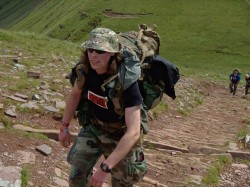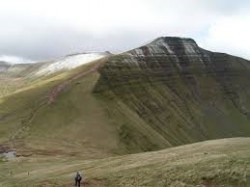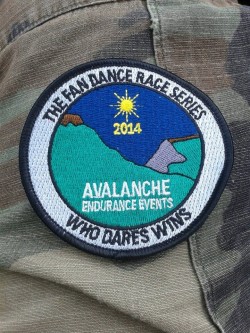 On the 5th of July 2014, I stood by the Storey Arms outside the town of Brecon, South Wales. Standing by the fabled red phone box in the early morning mist, the sense of anticipation was palpable. Milling about were sportsmen and women from all walks of life, IT developers, teachers, students, fitness fanatics and of course a collection of military personnel in there maroon t-shirts and Marines in their distinctive green and the bright red and white feather of a Fusilier. A motley crew to say the least! We all had one goal, to reach the summit of Pen Y Fan and completed the fabled Fan Dance selection march, the yardstick for UK Special Forces selection. A half marathon over unforgiving terrain and steep inclines with 35+ pounds of kit on your back. This is an endurance race like no other.
On the 5th of July 2014, I stood by the Storey Arms outside the town of Brecon, South Wales. Standing by the fabled red phone box in the early morning mist, the sense of anticipation was palpable. Milling about were sportsmen and women from all walks of life, IT developers, teachers, students, fitness fanatics and of course a collection of military personnel in there maroon t-shirts and Marines in their distinctive green and the bright red and white feather of a Fusilier. A motley crew to say the least! We all had one goal, to reach the summit of Pen Y Fan and completed the fabled Fan Dance selection march, the yardstick for UK Special Forces selection. A half marathon over unforgiving terrain and steep inclines with 35+ pounds of kit on your back. This is an endurance race like no other.
Standing there in the morning mist at the base of the climb looking up wondering if it would clear or would it be a rain soaked slog to the top, my mind wandered back 4 and half weeks, to news that I thought would put an end to my ambitions as a sportsman.
On the 27th of June I got a hurried call from my GP informing me that the results of my blood test had come back early and that I would need to see him urgently. I was not surprised that something was wrong, I had been feeling run down and tired for quite some time. I would never have guessed that it was diabetes.
I have been active since my teens, taking up rowing at the age of 14. Since then I have been involved in numerous activities. Cycling, hiking and climbing to name a few. I knew very little about the practicalities of diabetes or at that moment what type I had or the difference between type 1 and type 2. All I could think about was that my sporting days were over!
I was aware of Steve Redgrave and his diagnosis in 1997, I grew up watching him achieve Olympic glory. But to my mind, Redgrave was an Olympic athlete with a superb medical staff and support team. As far as I was concerned I was finished.
Within in the week my point of view changed and although the change was hard to deal with initially it became apparent that my initial fears about my sporting lifestyle and my hobbies was not only unfounded but also baseless.
To the credit of my dietician, the first thing I was told was that “nothing was off limits”. This helped ease the worry I had been feeling over the previous few days.
Once I had gone through the mill and been briefed as to what I had to do and how to manage type 1, I began to plan ahead.
Sport has always been a source of great enjoyment for me, I reasoned that to get over this hurdle as fast as possible was to get to grips with type 1 in a practical sense and learn how to 1st control it, 2nd use it to get back to full fitness and 3rd to mentally take control of it to allow me to rule it and not the other way around.
The Fan Dance was the answer to the problem, having booked the ticket to participate in late December I had been training consistently for it for a number of months. Despite feeling run down and tired all the time I was noticing that the running and pack marches were getting easier. Of course nothing prepares you for the real thing, much like diabetes, it is very much a steep learning curve. But with Pen Y Fan on the horizon it was time to get to grips with type 1 as fast as possible to give myself a fighting chance and completing this challenge and return to normality. What a challenge, designed to test UKSF candidate’s to the limits of endurance and mental strength the Fan Dace is a well known for having a high failure rate. With the help of the Diabetic Day Care Centre staff, Margaret, Trish and Dr Tuttehill at Cork University Hospital I began to plan my insulin and testing regime for the march.
Working out the carbohydrate requirements and fluid intake to sustain me for the 4+ hours it was going to take. Having lost over 5kgs in body weight before diagnosis it was going to be tricky.  With 4 and half weeks before the event I began to eat as normal and carb count, make adjustments to my insulin and testing rigorously. On one 10km March testing every 20 minutes and consuming sports gels and drinks to keep the body functioning properly to avoid ketoacidosis and hypos.
With 4 and half weeks before the event I began to eat as normal and carb count, make adjustments to my insulin and testing rigorously. On one 10km March testing every 20 minutes and consuming sports gels and drinks to keep the body functioning properly to avoid ketoacidosis and hypos.
I was also very fortunate that my race partner and close friend Andrew Barrett is also a pharmacist, who has extensive experience with diabetes and is quite knowledgeable about the condition and provide me with advice as well as the various items needed to test and manage the diabetes. On a practical level he was also quite helpful, keeping a look out for the signs of hypoglycemia. During the first training march after diagnosis I had my first Hypo and he spotted it immediately and got me to test. As a result of this I built a logbook of figures over the test march distances, which allowed me to plan the intake accordingly. The knock on of this was that I know when to take carbs based on time and distance. It makes the whole process easier and in every day life as well.
08:30 July 5th we gathered around Ken Jones at the base of Pen Y Fan, he gave us a short and to the point race brief. Knowing full well that everyone standing around him knew the history of the Fan Dance and the difficulties ahead. All he said was GO!!
With that we trudged up into the mist under crushing loads. I began testing my blood sugar levels within 25m minutes of the start and topping up on sports gels and water. I would repeat this process 15 times over the next 4+ hours. As we gained altitude the sun began to break through the clouds revealing the splendid South Wales countryside and the way ahead. By the time I had reached Rendezvous 2 (RV2) it had begun to get very hot and making sure to take on plenty of water and keep the blood sugar levels up.
The mental challenge of turning around and covering the same ground you had just traversed is very tough, especially as you look up at Pen Y Fan from the Roman Road below it. Reaching a gut wrenching 29.6% gradient carrying 35lbs having been marching for 3hrs it begins to take its toll on the mind and body. Looking around as we climbed to the summit, everyone was under pressure. I had saved a bottle of coke for this part and it acted as a liquid morale boost and kept my sugar up.
The march was nearly over, but we still had a bit to go. A few words of encouragement from Ian Ford at RV3 and John Whelton were really appreciated. Surprisingly it was my knee that gave up before the finish. Still I trudged onwards descending the final slope to the finish and the coveted Fan Dance finisher’s patch. A shake of hands and a few words with Ken Jones and it was over. In that moment I had proved to myself that the diabetes was not the end of my ambitions in any way shape or form.
The main lesson here is that Type 1 is not the end of anything. With research and management it becomes less daunting. Admittedly I did not choose an easy path to overcome it. But I think it is vital to set a goal from the outset and move to complete it. Do not let your diabetes run you, you must run it!
I’m not advocating that you go out and do something irrational or ignore the advise of your medical professionals. This was only possible because of them. But aim to be the best diabetic you can and do everything in your power to overcome it.
Emmet Foley



